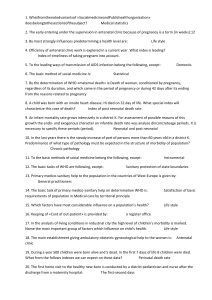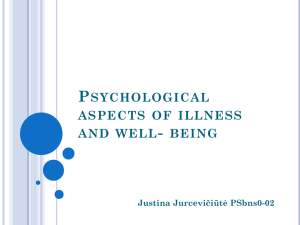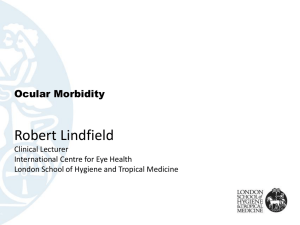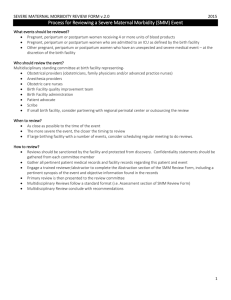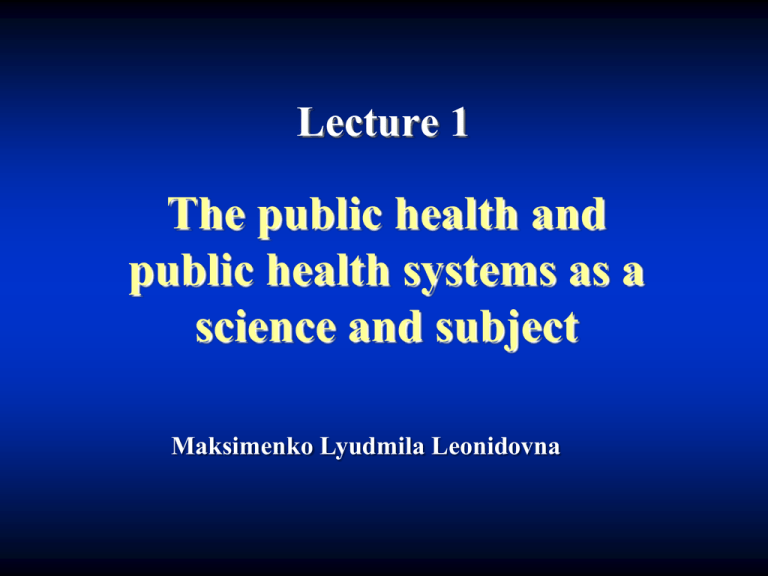
Lecture 1
The public health and
public health systems as a
science and subject
Maksimenko Lyudmila Leonidovna
The public health and public health
systems is a science studying:
• The health of a population,
• its forming factors and conditions,
• and creating the treatment and
prophylactics methods aimed at
public health improvement
Basic historical events in the development of
Public health and Public health systems
The history of occurrence of our science is
closely connected with the need of doctors to
explain the reasons of health and illnesses of
their patients and also to learn to control their
health. From time immemorial man has been
interested in trying to control disease. It is
possible to give many examples from history of
medicine confirming that many doctors
connected occurrence of diseases with adverse
conditions of a life of their patients.
Basic historical events in the development
of Public health and Public health systems
Among many names in Hindu medicine, that of
Susruta, the “Father of Indian surgery” stands out in
prominence. He compiled the surgical knowledge of his
time in his classic “Susruta Samhita” (it was compiled
between 800 BC and 400 AD). Though this work is
mainly devoted to surgery, it also includes medicine,
pathology, anatomy, midwifery, ophthalmology,
hygiene and bedside manners. Susruta taught attentive
supervision over the patient: how he behaves, how he
eats, how has a rest, how answers questions; that is
what is the character of his behavior and the vital
circumstances which have led to illness. For treatment
Susruta recommended different diets, physical
exercises, conditions change.
Great Hippocrates (460-370 BC) who is
often called the “Father of Medicine”
"The majority of illnesses depend on
acts, thoughts of the person and his
life conditions."
He studied such things as climate,
water, clothing, diet, habits of eating
and drinking and the effect they had
in producing disease.
His book “Airs, Water and Places” is
considered a treatise on social
medicine
and
hygiene.
The
Hippocratic concept of health and
disease stressed the relation between
man and his environment.
Abu Ali Ibn-Sina (980-1037)
The great doctor of
medieval East Abu Ali
Ibn-Sina known to the
western
world
as
Avicenna named three
important conditions for
health preservation:
• moderate physical
exercises,
•a rational diet
•and sleep.
Bernardino Ramatstsini (1633 – 1714)
Italian doctor Bernardino
Ramatstsini has proved
for the first time that not
only conditions of life and
behavior of a person, but
also working conditions
can cause illness. Its
scientific
work
"Reasoning's on illnesses
of
handicraftsmen"
contains the description of
60 occupational diseases
with specifying of their
reasons, preventive and
treatment measures.
Many Russian doctors also considered, that "it is
necessary to treat not illness, but a patient", that
is a person taking into account individual
character, temperament, life and work
conditions. At the end of the 18th century many
of the professors of the Moscow University
stressed the necessity of public health study and
introduction of a new subject at medical
faculties. But the lecture course on public health
has been introduced only in the second half of
the 19th century, and only at several medical
faculties and occasionally.
Formation of a new science studying public health
has occurred at the very beginning of the 20th
century in Germany. Interest to public health in
Germany has been caused by adoption of the law
of social insurance providing three sources of
payment for medical aid: means of the state
budget, businessmen’s profit, and workers’
inpayments. Under new conditions, businessmen
became interested in studying health state of
workers, morbidity decrease, carrying out of
preventive measures. A German doctor Alfred
Grotjan became a founder of social hygiene (the
original name of a science studying public health
state).
In 1903 Alfred Grotjan began publishing a
magazine on social hygiene, and in 1905 he
founded a scientific organization on social
hygiene and medical statistics in Berlin. In 1920
Alfred
Grotjan
became
successful
in
establishment of the Chair of Social Hygiene at
Medical Faculty of the Berlin University. At the
same time Renе Zand founded the Belgian
Social and Medical Association, and at his
initiative the similar chairs have been opened at
other universities of Europe. In 1922 the first
chair of social hygiene was set up at the Moscow
University, and in succeeding years all medical
higher schools in our country have opened such
chairs.
In the thirtieth years of the last century in other
countries of the world the chairs studying public
health have opened. Social hygiene is a young
science; it still continues to be formed and
consequently has no common unitized name as a
teaching subject. In many countries this subject
is called social medicine, medical sociology,
preventive and social medicine, sociology of
public health services (USA), public health. In
the resent years in Russian medical higher
schools this subject got the name "Public health
and public health systems." But however this
subject was called, it is taught in all medical
higher schools and studies, first of all, condition
of public health and factors forming it.
А definition of "health"
In the modern literature there is a
considerable quantity of definitions of
"health," however the basic one, adopted in
all countries, is a definition of the World
Health Organization (WHO). In the WHO
Charter accepted in 1948 it is written:
"Health is a condition of full physical,
spiritual and social well-being, and not
just absence of illnesses and physical
defects."
In medico social researches, at health
estimation, it is accepted to point out four levels:
1. Health of a separate person – individual health;
2. Health of social and ethnic groups – group
health;
3. Health of the population of administrative
territory – regional health;
4. Health of population, a society as a whole –
public health.
Unlike the majority of medical and clinical disciplines
dealing with a separate person, an individual and his
health, public health and public health systems studies a
state of health of all population of the country.
For a quantitative estimation of group, regional
and public health it is customary to use the
following indices:
1. Demographic indices (death rate, birth rate,
average life expectancy).
2. Morbidity rate.
3. Disability rate.
4. Indicators of physical development of the
population.
The greater part of these indicators is of negative
character; it concentrates doctors’ attention to
pathological conditions and health definition through
morbidity intensity.
However, in the majority of countries of the
world the main function of public health services
system at present is prevention of diseases and
health preservation of healthy people; that is
why it is very important to use the indicators
positively estimating health. They are:
1. A health index – a share of practically healthy
population, which did not appeal for medical
aid on account of diseases within a year;
2. Average duration of healthy life and others.
At a complex estimation of health of separate
patients and population health as a whole the
following five groups of health are distinguished:
1st group – practically healthy people – the persons who do
not have chronic diseases and functional deviations,
seldom and short being ill with acute diseases;
2nd group – risk group – persons who do not have chronic
diseases, but have functional deviations in activity of
various organs and systems, and also persons being
frequently and prolonged ill with acute diseases;
3rd group – chronic patients with a compensated form of
disease and preserved functional abilities of the body;
4th group – chronic patients with a sub compensated form
of disease and with reduced functionality of the organism;
5th group – chronic patients with a decompensate form of
disease and invalids.
In public health study the following
classification of factors that define it is applied:
• Social and economic factors (material well-being,
living conditions, working conditions, food quality,
mutual relations in a family and others);
• Biological factors (sex, age, heredity, temperament
etc.);
• Ecological, natural and climatic factors (climate,
weather, air condition, water, soil, level of solar
radiation, etc.);
• Medical and organizational factors (availability and
quality of a medical and social help).
Conditions of a personal and collective life can
be united and form a concept – a way of life.
A way of life means the most important
features of the life and behaviour of people
in a definite social environment, society.
The way of life includes • The activity directed on
set of features
health preservation and
prevention of diseases, can
characterizing
• activity of people at a
factory and in a
household,
• political, cultural,
physical, educational
activity,
• medical activity and
others.
form a healthy way of life.
• A healthy way of life is
favorable conditions of vital
activity of a person, high
level of culture and hygienic
habits, allowing to keep
health, to prevent from
development of diseases.
Features of Russians’ life-style
• Regularly go in for physical training - 12 % of
Russians
• Abuse spirits – more than 30 million persons
(21 %)
• Regularly take drugs –nearly 2million people
• Smokers - 45 % of the population
Formation of a healthy way of life in these
conditions is the basic means of primary
preventive maintenance and should become
the basic purpose of social policy and major
duty of all medical workers.
The influence of separate factors
on public health
• Nature-climatic factors.
The sharp change of atmospheric processes
leads to morbidity growth. So, for example,
fluctuations
of
atmospheric
pressure
negatively influence cardiovascular system,
and temperature drops lead to increase of
respiratory diseases. . Shortage in water and
soil of some microelements (iodine, fluorine
and others) leads to occurrence of diseases
endemic for this district.
Environmental contamination causes increase in level of
morbidity and death rate of the population. So, in cities
with well developed industry high concentration of
harmful substances in air, water and soil leads to increase
of prevalence of illnesses of respiratory system, kidneys
and oncological diseases.
Emissions of harmful substances into atmospheric air
(thousand tons)
Influence of biological factors on health of the person is
easy for tracking at studying of morbidity level in children
of a different sex.
Morbidity level in
children during the
first three years of life
is highest, and then
morbidity decreases.
Morbidity level of boys
during the first six
years
of
life
is
essentially above the
morbidity level of their
contemporary-girls, at
age of six years
morbidity levels are
leveled, and further
morbidity of girls is
always higher, than at
boys.
Children morbidity level depending on
age and sex (‰)
4000
3500
3800
3100
3000
2600
2500
2250
1800
2000
1600
1500
1300
1000
500
0
1
3
girls
5
7
10
Age in years
14
17
boys
Influence of biological factors on health of the
person
•Infectious diseases at children happen much
more often, than at adults, but with age increase
prevalence of illnesses of blood circulation
system and death rate from them grow.
•Indices of morbidity and death rate from
malignant growths increase with age, but at
women they are considerably lower, than at
men.
A parity of social and biological
features
The person, entering into this world, receives health
as gift of the nature, which he has inherited from
ancestors. However the biological origin is never
shown in the person in purely natural form. The man
is a unique phenomenon of a society and the nature,
representing a social and biological alloy. A problem
of a parity of social and biological features in the
person is a key to understanding of the nature and
character of health of the person, its illnesses which
needs to be considered as biosocial categories.
In documents of the WHO it was repeatedly specified,
that, first of all, health of people is a social category, so for
public health estimation the WHO recommends following
indices:
• Payment of a total national product to public
health services.
• Availability of the primary medico-social help.
• Coverage of the population with medical aid.
• Level of immunization of the population.
• Degree of survey of pregnant women by
qualified personnel.
• Condition of children’s diet.
• Level of children's death rate.
• Average duration of a forthcoming life.
• Hygienic literacy of the population.
Dependence between income average level
per capita and life expectancy
Countries
Bangladesh
India
Algeria
Mexico
The Netherlands
The USA
Compare the
Average life
income per capita expectancy
in US dollars
(years)
92
46
133
52
780
59
996
65
5568
74
7034
76
• Social conditionality of health proves to be true by
numerous medico-social researches. So, for example, while
studying dependence between income average level per
capita and average life expectancy worldwide it is easy to
notice, that with income increase per capita average life
expectancy increases also.
Death rate of the population of the USA
depending on the marital status (%)
Age in
years, sex
Unmarried
persons
Married
The
dissolved
3,4
2,0
1,5
0,9
5,3
2,2
15,7
6,4
8,4
4,5
25,9
7,2
38,0
14,6
25,3
13,1
57,0
17,3
25-34
male
female
45-54
Male
female
60-64
male
female
• The American scientists have determined that the state of
health in many respects depends on the marital status. Both
at married men and women a death rate is essentially lower,
than at unmarried and especially dissolved
The force of complex influence the main of
factors on public health
The factors defining health of the population, cooperate with each other, have regional features, and
vary in time. At complex medico-social research the
most possible number of factors is taken into
consideration, their interrelation and force of influence
of each of them. Scientists of our country managed to
calculate, that such major index of health as morbidity
is caused to 50 % by conditions and a way of life, to 2025 % by condition (pollution) of an environment, to 20
% by genetic factors and to 10-15 % by public health
services condition. For other indices of health above
resulted rates can be others; however the leading part
of conditions and a way of life remains invariable.
Share of separate risk factors in
formation of health of the population
10%
20%
50%
20%
Coditions and way of life
Condition of an environment
Genetic fators
Pablic health services condition
Rick factors
The population state of health depends on influence of
various external and internal factors. The factors which
are potentially hazardous to health of a person,
promoting occurrence of diseases, are called risk factors.
A task of the state and public health services system is to
decrease intensity of risk factors influence and to
strengthen the factors positively influencing on health.
The concept that disease is due to multiply factors is not
a new one. It is known that diseases such as coronary
heart disease and cancer are due to multiple factors. For
example, excess of fat intake, smoking, lack of physical
exercise and obesity are all involved in the pathogenesis
of coronary heart disease. Most of these factors are
linked to lifestyle and human behavior.
Rick factors
For many diseases, the disease “agent” is still
unidentified, e.g. coronary heart disease, cancer, peptic
ulcer, mental illness, etc. Where the diseases agent is
not firmly established, the aetiology is generally
discussed in terms of “risk factors”.
The term “risk factors” is used by different authors
with at least 2 meanings:
• an attribute or exposure that is significantly
associated with the development of a disease,
• a determinant that can be modified by intervention,
thereby reducing the possibility of occurrence of
disease or other specified outcomes.
• Rick factors are often suggestive, but absolute proof of cause
and effect between a risk factor and disease is usually lacking.
That is, the presence of a risk factor does not imply that the
disease will occur, and in its absence, the disease will not occur.
The important thing about risk factors is that they are
observable or identifiable prior to the event they predict. It is
also recognized that combination of risk factors in the same
individual may by purely additive or synergistic (multiplicative).
For example, smoking and occupational exposure (shoe, leather,
rubber, dye and chemical industries) were found to have an
additive effect as risk factors for bladder cancer. On the other
hand, smoking found to be synergistic with other risk factors
such as hypotension and high blood cholesterol. That is, the
effects are more than additive.
• Risk factors may be truly causative (e.g., smoking for lung
cancer); they may be merely contributory to the undesired
outcome (e.g., lack of physical exercise is a risk factor for
coronary heart disease), or they may be predictive only in a
statistical sense (e.g., illiteracy for perinatal mortality).
Modifiable and unmodifiable risk factors
• Some risk factors can be modified; others cannot be modified.
The modifiable factors include smoking, physical activity, diet.
They are amenable to intervention and are useful in the care of
the individual. The unmodifiable or immutable risk factors
such as age, sex, race, family history and genetic factors are not
subject to change. They act more as signals in alerting health
professionals and other personnel to the possible outcome.
• Risk factors may characterize the individual, the family, the
group, the community or the environment. For example, some
of the individual risk factors including age, sex, smoking, etc.
But there are also collective community risks – for example,
from the presence of malaria, from substandard housing or a
poor water supply or poor health care services. The degree of
risk in these cases is indirectly an expression of need. Therefore
it is stated that a risk factor is a proxy for need – indicating the
need for promotive and preventive health services.
The detection of risk factors are a prelude to
prevention.
• Epidemiological methods (e.g., case control and cohort studies)
are needed to identify risk factors and estimate the degree of
risk. These studies are carried out in population groups among
whom certain diseases occur much more frequently than other
groups. By such comparative studies, epidemiologists have been
able to identify smoking as a risk for lung cancer; high serum
cholesterol and high blood pressure as risk factors for coronary
disease. The detection of risk factors should be considered a
prelude to prevention. For each risk factor ascertained, the
question has to be asked whether it can be reduced in a costeffective way and whether its reduction will prevent or delay
the unwanted outcome. Since the detection procedure usually
involves whole population, it bears some similarity to
presymptomatic screening for disease.
Risk groups
• Another approach developed and promoted by WHO is
to identify precisely the “risk groups” (e.g. at-risk
mothers, at-risk infants, at-risk families, chronically ill,
elderly) in the population by certain defined criteria and
direct appropriate action to them first. This is known as
the “risk approach”. It has been summed up as
“something for all, but more for those in need – in
proportion to the need”. In essence, the risk approach is
a managerial devise for increasing the efficiency of
health care services within the limits of resources.
WHO has been using the risk approach in MCH
services for sometime.
Guidelines for defining “at-risk” groups
1. Biological situation:
- Age group, e.g., infants (low birth weight), elderly
- Sex, e.g., females in the reproductive age period
- Physiological state, e.g., pregnancy, high blood pressure
- genetic factors, e.g., family history of genetic disorders
- other health conditions (disease, physical functioning, unhealthy
behaviour)
2. Physical situation:
- rural, urban slums
- living conditions, overcrowding
- environment: water supply, proximity to industries
3. Socio-cultural and cultural situation:
- social class
- ethnic and cultural group
- family disruption, education, housing
- customs, habits and behavior
- access to health services
- lifestyles and attitudes
Conclusion:
Modern epidemiology is concerned with
the identification of risk factors and highrisk groups in the population. Since
resources are scarce, identification of those
at risk is imperative. It helps to define
priorities and points to those most in need of
attention.
The knowledge of risk factors and risk
groups can be used to prevent disease in so
far as we are able to remove or minimize the
risk.




